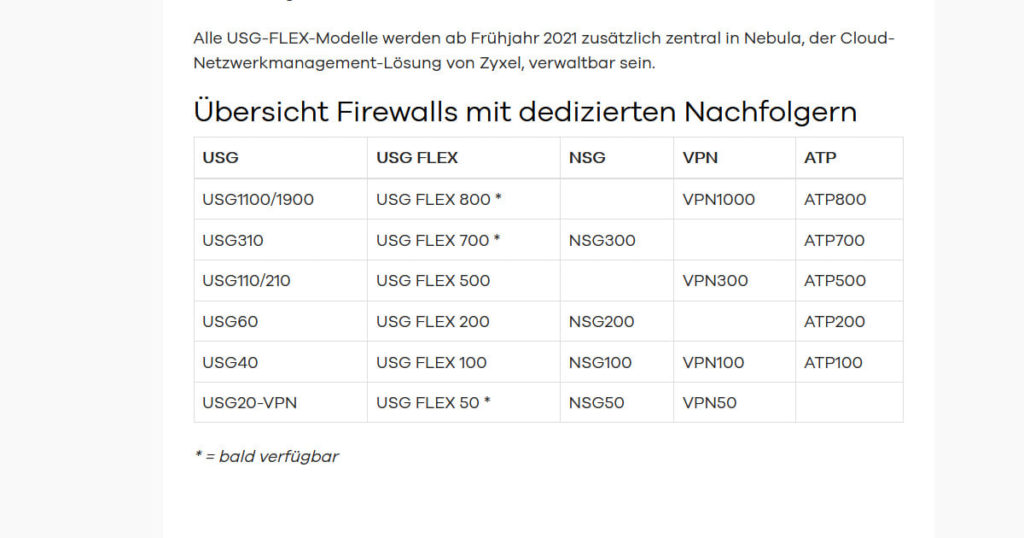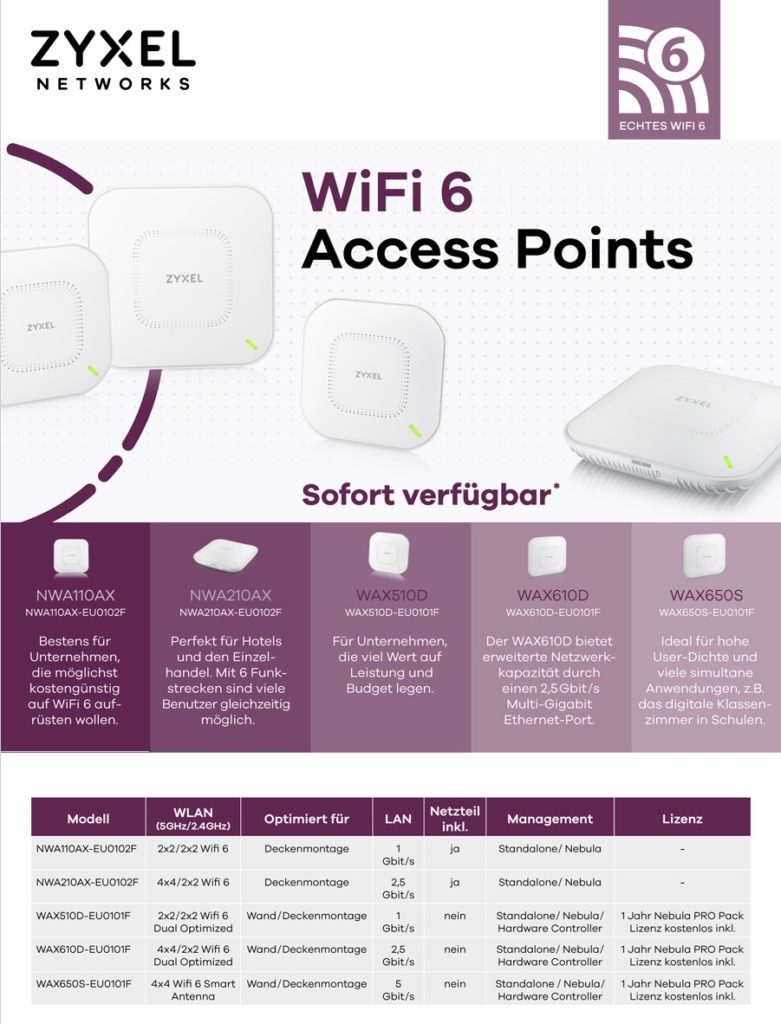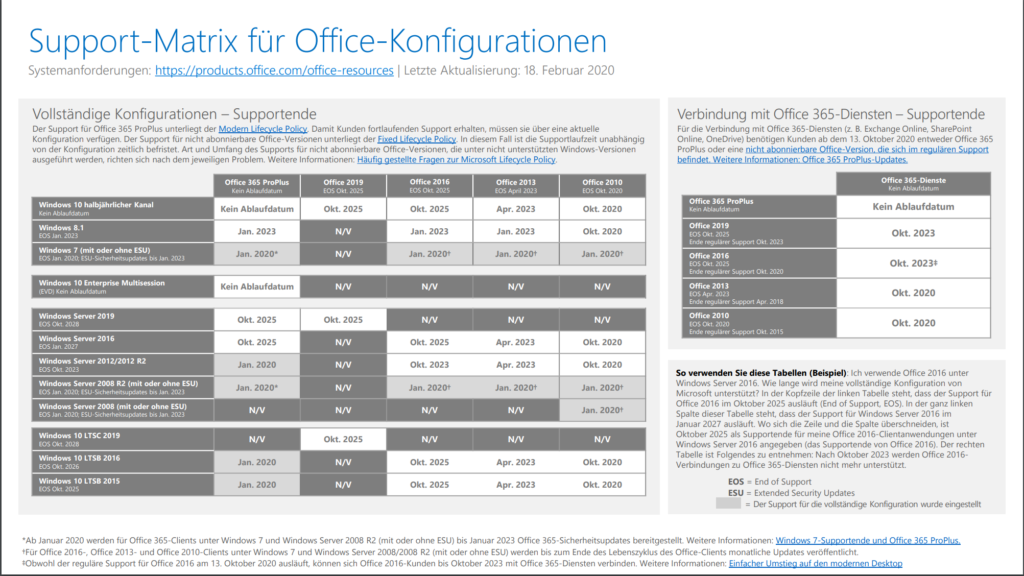
Alle Beiträge von Mag. Jochen Reckzigel (Redaktion)
ZYXEL WIFI 6 AccessPoints
Trend Micro Endpoint Suites – path from legacy to new technology
Office versions and connectivity to Office 365 services
Quelle: Link
Starting on October 13, 2020, only these versions of Office will be supported for connecting to Office 365 (and Microsoft 365) services:
- Microsoft 365 Apps for enterprise (previously named Office 365 ProPlus)
- Microsoft 365 Apps for business (previously named Office 365 Business)
- Office 2019, such as Office Professional Plus 2019
- Office 2016, such as Office Standard 2016
Examples of Office 365 services include Exchange Online, SharePoint Online, and OneDrive for Business.
Important
We won’t take any active measures to block other versions of the Office client, such as Office 2013, from connecting to Office 365 services, but these older clients may encounter performance or reliability issues over time.
Impact of using older Office clients to connect to Office 365 services
After October 13, 2020, ongoing investments to our cloud services will not take into account older Office clients. Over time, these Office clients may encounter performance or reliability issues. Organizations that use these older clients will almost certainly face an increased security risk and may find themselves out of compliance depending upon specific regional or industry requirements.
Therefore, administrators should update older Office clients to versions of Office supported for connecting to Office 365 services.
Upgrade resources available to administrators
We recommend that you upgrade older Office clients to a subscription version of the Office client, such as Microsoft 365 Apps for enterprise. The most up-to-date subscription versions of the Office client are always supported connecting to Office 365 services.
We provide various services to help you upgrade to subscription versions of the Office client. The following list provides some examples of resources that are available:
- Microsoft FastTrack, for migration and deployment assistance from Microsoft experts.
- App Assure, for assistance from Microsoft with application compatibility issues.
- Deployment guide for Microsoft 365 Apps, for technical documentation.
- Product lifecycle dashboard and upgrade readiness dashboard, for users of Microsoft Endpoint Configuration Manager (current branch).
- Readiness Toolkit for Office add-ins and VBA, to help identify potential issues with add-ins and VBA macros used in your organization.
Upcoming changes related to connectivity to Office 365 services
Retirement of TLS 1.0 and 1.1
After October 15, 2020, you must be using at least TLS 1.2 to connect to Office 365 services. For more information, see TLS 1.0 and 1.1 deprecation for Office 365 and Preparing for TLS 1.2 in Office 365 and Office 365 GCC.
Basic authentication with Exchange Online
There are some changes planned related to the use of Basic Authentication with Exchange Online. For more information, see Basic Authentication and Exchange Online – April 2020 Update.
Additional information about connectivity to Office 365 services
- Versions of Office 2019 and Office 2016 are supported until October 2023.
- Connecting to Office 365 services using Office 2016 for Mac isn’t supported after October 13, 2020. That’s because Office 2016 for Mac reaches end of support on that date.
- This information about connecting to Office 365 services also applies to Project and Visio.
- This information about connecting to Office 365 services does not apply to InfoPath 2013 or SharePoint Designer 2013.
- For end of support dates for different versions of Office on various versions of Windows, see the Office configuration support matrix.
- To discuss or learn more about end of support for Office versions, visit Microsoft Office End of Support on the Microsoft Tech Community.
Ressourcen zu Microsoft 365 und Office
Revised end of service date for Windows 10, version 1709: October 13, 2020
Quelle: https://techcommunity.microsoft.com/t5/windows-it-pro-blog/revised-end-of-service-date-for-windows-10-version-1709-october/ba-p/1239043#
Right now, we have a lot of concerns. For our families and colleagues. For our businesses and our customers. Many of us are now working remotely, and all of us have had our day-to-day lives impacted in unique ways. At Microsoft, our top priority is the health and safety of our employees, customers, partners, and communities.
We have been evaluating the public health situation, and we understand the impact this is having on you, our valued customers. To ease one of the many burdens you are currently facing, and based on customer feedback, we have decided to delay the scheduled end of service date for the Enterprise, Education, and IoT Enterprise editions of Windows 10, version 1709. This means devices will receive monthly security updates only from May to October. The final security update for these editions of Windows 10, version 1709 will be released on October 13, 2020 instead of April 14, 2020.
Security updates for Windows 10, version 1709 will be available via our regular servicing channels: Windows Update, Windows Server Update Services, and the Microsoft Update Catalog. You will not need to alter your current update management workflows. For example, all supported versions of Microsoft Configuration Manager (current branch) will continue to support Windows 10, version 1709 until October 13, 2020.
If you haven’t yet done so, we encourage IT teams to consider shifting to Windows Update for Business, which allows users to take both feature updates and quality updates directly from Microsoft in a secure and often faster manner. You can also consult our Windows as a service resources for steps you can take to keep your Windows 10 devices up to date.
For a comprehensive list of end-of-service dates for all versions and editions of the Windows client and Windows Server operating systems, bookmark the Windows lifecycle fact sheet or utilize the Microsoft Lifecycle Policy search tool to find lifecycle information for all commercial Microsoft products. We recommend you bookmark the Windows message center and follow @WindowsUpdate for the latest news and announcements.
Basic Authentication and Exchange Online – April 2020 Update
| Major update: Announcement started | ||
| Applied To: All |
| In response to the unprecedented situation we are in and knowing that priorities have changed for many of our customers we have decided to postpone retiring Basic Authentication in Exchange Online (MC204828) for those tenants still actively using it until the second half of 2021. We will provide a more precise date when we have a better understanding of the impact of the situation. [How does this affect me?] We will continue to disable Basic Authentication for newly created tenants by default and begin to disable Basic Authentication in tenants that have no recorded usage starting October 2020. And of course you can start blocking legacy authentication today, you don’t need us to do anything if you want to get started (and you should). We will also continue to complete the roll-out of OAuth support for POP, IMAP, SMTP AUTH and Remote PowerShell and continue to improve our reporting capabilities. We will publish more details on these as we make progress. [What do I need to do to prepare?] This change allows you more time to update clients, applications and services that are using Basic Authentication to use Modern Authentication. |
Namensänderung für mehrere Microsoft Services

Das wird sich nicht ändern:
Produktmerkmale und Nutzungsrechte
Basic Authentication Retirement for legacy protocols in Exchange Online
Hauptupdate: Ankündigung
Gilt für: All customers
Updated February 7, 2020: Changed the Action by Date to accurately reflect October 13, 2020. Beginning October 13, 2020, we will retire Basic Authentication for EWS, EAS, IMAP, POP and RPS to access Exchange Online. Note: this change does not impact SMTP AUTH. There are several actions that you and/or your users can take to avoid service disruptions on client applications, and we describe them below. If no action is taken, client applications using Basic Authentication for EWS will be retired on October 13, 2020. Any application using OAuth 2.0 to connect to these protocols, will continue to work without change or interruption.
What do I need to do to prepare for this change?You have several options on how to prepare for the retirement of Basic Authentication.
- You can start updating the client applications your users are using to versions that support OAuth 2.0 today. For mobile device access, there are several email apps available that support Modern Authentication, but we recommend switching to the Outlook app for iOS and Android as we believe it provides the best overall experience for your M365 connected users. For desktop/laptop access, we encourage the use of the latest versions of Outlook for Windows and Outlook for Mac. All Outlook versions including, or newer than, Outlook 2013 fully support OAuth 2.0.
- If you have written your own code using these protocols, you will need to update your code to use OAuth 2.0 instead of Basic Authentication, you can reach out to us on stack overflow with the tag exchange-basicauth if you need some help.
- If you or your users are using a 3rd party application, which uses these protocols, you will either need to
- reach out to the 3rd party app developer who supplied this application to update it to support OAuth 2.0 authentication
- assist your users to switch to an application that’s built using OAuth 2.0.
We are in the process of building reports that will help you identify any impacted users and client applications in your organization. We will make these reports available to you in the next few months and communicate their availability via a follow-up Message center post. Please click Additional Information to learn more about this retirement.
Exchange and SameSite Updates
https://techcommunity.microsoft.com/t5/exchange-team-blog/exchange-and-samesite-updates/ba-p/1127984
Exchange and SameSite Updates
The Stable release of the Google Chrome web browser (build 80, scheduled for release on February 4, 2020) features a change in how cookies are handled. Although the change is intended to discourage malicious cookie tracking, it’s also expected to severely affect many applications and services that are based on open standards.
For more information, see SameSite Updates on the Chromium Projects website.
Microsoft is committed to addressing this change in behavior in its products and services before the February 4, 2020 rollout date to ensure our customers are minimally impacted.
Exchange Online has already rolled out changes necessary to support this change and we do not anticipate any issues.
Exchange Server’s March Cumulative Updates will contain changes necessary to support this change. We will issue CU’s for Exchange Server 2016 and 2019 and we recommend upgrading to these versions to ensure compatibility. We’re investigating solutions for earlier versions of Exchange Server.
Given the date of our scheduled CU’s comes after Google Chrome’s release date of February 4th there might be some issues experienced by users.
To avoid issues, we recommend users switch to an alternate browser, or configure the site/URL used by OWA users to be excluded from the SameSite enforcement behavior in Chrome by using the LegacySameSiteCookieBehaviorEnabledForDomainList setting.
Additional information can be found on this page.
The Exchange Team


